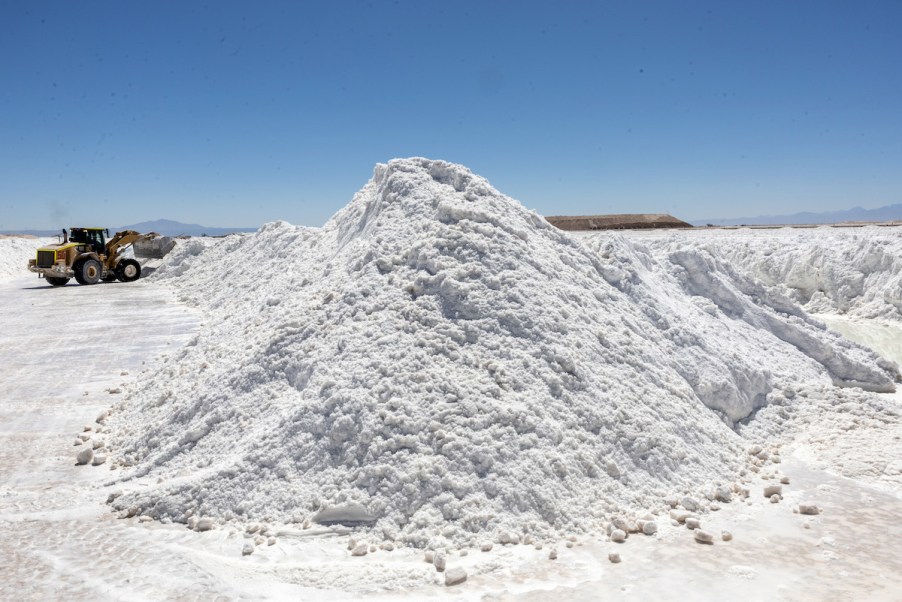
All-Electric Lithium Mine Set to Power 5 Million EVs
With automakers scrambling to scale their electric fleet production, many components and commodities are now in high demand. The semiconductor chip shortage has dominated headline news for the past couple of years. But chips aren’t the only thing automakers lack. The demand for lithium has also recently surged, as it is critical to manufacturing the batteries that power EVs. Fortunately for U.S. manufacturers, the Snow Lake Lithium mine promises to supply enough of the mineral to help power millions of EVs.
Why lithium is critical to EV production

As per Energy X, EVs require batteries to operate that can store large amounts of energy. The more they can store, the more range a vehicle will have. They also need to be able to be recharged frequently without significant degradation. Otherwise, drivers would find themselves replacing their batteries more often than they’d like.
Lithium isn’t the only mineral that can store a significant charge and be recharged relatively frequently. But it does handle electric charges more efficiently than other substances. Lithium-ion batteries have already been used by cellphones, laptops, and solar battery devices, among other electronics. But for them to serve as the standard for the auto industry requires a massive increase in mining, refining, and distribution.
On average, EV battery systems contain 17 lbs. of lithium. When you consider how many millions of cars are sold each year in the U.S. alone, you’ll see just how massive the demand is for lithium each year. Moreover, automakers are continuing to find new ways to expand the charging capacity and driving range that can be harnessed from lithium-ion batteries. So even while some companies are investing in alternatives, the lithium-ion battery will remain the industry standard for years.
Additionally, the U.S. has been working to reduce its dependency on foreign suppliers for key technologies and materials. To that end, the Inflation Reduction Act of 2022 incentivizes U.S. automakers to produce their vehicles onshore. These incentives put more pressure on domestic suppliers of lithium, and other materials, to expand their operations.
Scaling up U.S. lithium production
Mining companies are indeed working diligently to increase capacity. According to Electrek, Salt Lake Lithium recently announced its projections for the next decade: 160,000 tons. That’s enough to power 500,000 EVs each year. Over the next decade, that’s 5 million EVs.
Those numbers are likely music to the ears of General Motors, Stellantis, and Ford executives who’ve been ramping up EV production and other manufacturers that produce solely EVs such as Tesla. It will allow these companies to take advantage of tax-based incentives to produce EVs. But as the EV market grows and matures, this lithium output will help automakers handle consumer demand which is expected to continue to grow.
Snow Lake Lithium’s projections are based on previously untapped land in Manitoba, Canada. Preparing the land for mining began in early 2022 and will take up to two years to complete. But once it is, it will be able to provide 160,000 tons more lithium to the market.
Why scaling up lithium production is the right move
Investing in new mining operations is a tremendously expensive endeavor. But investing in lithium production is as close to a safe bet as a company can have. An existing consumer market for the mineral exists outside of the automotive industry. And the auto industry’s efforts to electrify its fleet are part of long-term, multi-decade plans that will rely on a steady supply of lithium.
In 2021, with auto markets still recovering, 15 million vehicles were sold in the U.S. alone, as per U.S. News and World Report. This figure was about two million less than the nation’s pre-pandemic peak. Most established automakers have announced plans to electrify at least half their fleets over the next decade or two, if not sooner. This means as many as 7.5 million vehicles a year or more sold in the U.S. could be EVs or hybrids, requiring lithium. Salt Lake Lithium, operating at full capacity, could only supply lithium for about seven percent of them.
In case you’re skeptical that consumer demand for EVs will grow to match automakers’ production plans, EV sales increased by 60% in the first quarter of 2022 as per Car and Driver, and another 13% over that in the second quarter, according to CBT News. High gas prices, growing charging infrastructure, and new consumer purchase incentives are helping increase consumer interest and demand.
New entrants are also enticing consumers. Exciting models like Teslas and electrified versions of classics like the Ford 150 Lightning are helping increase the consumer adoption rate. Indeed, Reuters projects the nation might have as many as half of vehicles on the road be EVs by 2050.


